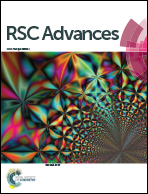Expanding the (cross-)hyperconjugation of 1,4-disilacyclohexa-2,5-dienes to larger monomers and oligomers: a computational investigation†
Abstract
We used density functional theory calculations to examine molecules that can be regarded as expanded 1,4-disilacyclohexa-2,5-dienes as well as oligomers based on these or 1,4-disilacyclohexa-2,5-diene with the aim to identify systems with extended (cross-)hyperconjugation. Among the three “expanded 1,4-disilacyclohexa-2,5-dienes” considered cyclobutadisilole is the most interesting as it has a higher thermodynamic stability than the isomeric 1,6-disilacyclodeca-2,3,4,7,8,9-hexaene and significantly lower first electronic excitation energy than 1,6-disilacyclodeca-2,4,7,9-tetraene. Cyclobutadisilole with trimethylsilyl substituents at Si shows particularly low excitations with the first strong transition at 3.46 eV (358 nm), i.e., ∼1.1 eV lower than in 1,4-disilacyclohexa-2,5-diene. The monomers were connected into oligomers via their Si atoms using bis(dimethylsilanediyl) linkers, and some extended hyperconjugation was revealed. The first allowed UV/Vis excitation in the cyclobutadisilole-based tetramers is calculated at 2.57 eV (482 nm), although the lowering in excitation energies when going from monomer to tetramer is merely ∼0.5 eV and hyperconjugation has modest impact on geometries. Yet, the tetra(cyclobutadisilole) has a significantly lower first allowed excitation when compared to a previously studied tetra(1,4-disilacyclohexadiene) with first excitation at 3.9 eV (318 nm).


 Please wait while we load your content...
Please wait while we load your content...